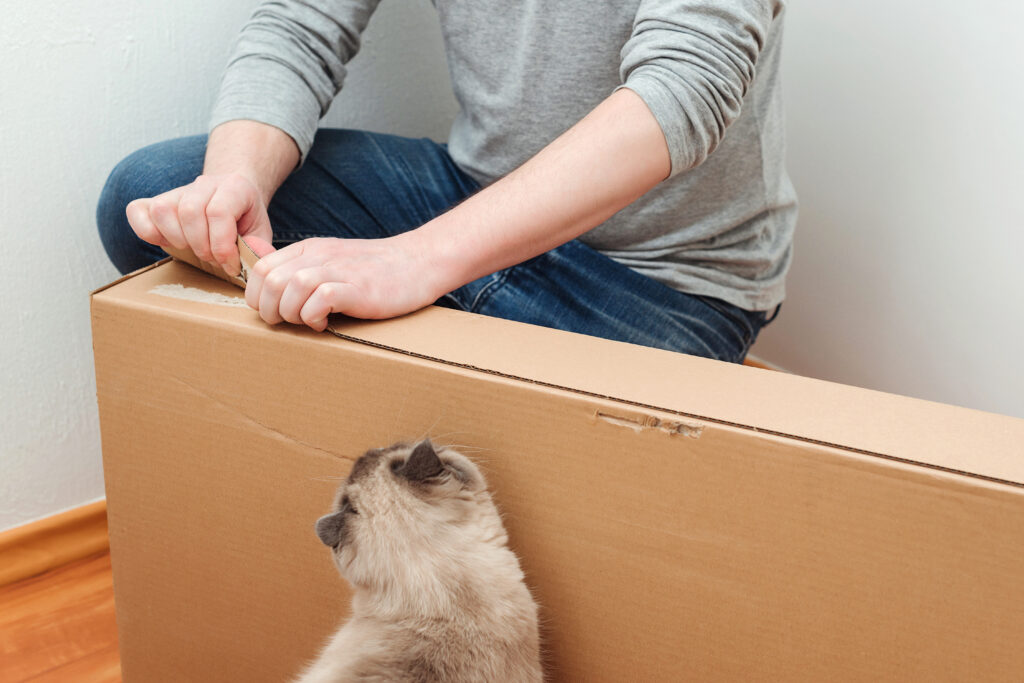The moving process is tough on everyone, but no one more so than our furry friends. When moving house with a cat, you want your pets transition to your new home to be seamless. You don’t want them to be scratching the new furniture out of stress or nibbling on the telephone cord.
Oftentimes the rapid changes in environment and routine are stressful on cats, making them behave in unusual ways. You want to get your kitty settled in as soon as you can, and Bassy’s Removals has the solution.
So what is the best way to go about moving with cats?
We have compiled our top tips for moving house with a cat, to give you the best chance at settling in with your feline friend.
1. Maintaining a consistent routine throughout the move
Routine is crucial to a cat’s overall well being. They thrive of regularity and consistency as most pets do. Parts of the day such as meal times, grooming and sleep and fundamental to a cat’s life. Maintaining a consistent routine, to the best of your ability, throughout your move will allow for your pet to continue doing what it knows and will hugely reduce its stress levels in and around your transition to a new home.
It is recommended that a routine is stuck to before, during and after the move has taken place. This will provide your pet with stability and will keep their usual activities consistent, encouraging your cat to continue as normal in the new home.
This is especially important to consider if you are moving an older cat to a new home. They are likely to have a longer-established routine, making it more important to maintain during the moving process.

2. Create a safe space zone for your cat
Perhaps one of the most effective ways to help your pet settle in when moving house with a cat is to establish a safe space zone for them.
This could be a spare bedroom, or any free area in the new home that can be filled with their food, water and other items. Toys and pieces of clothing or blankets that hold a familiar scent are a great addition to this space too as they remind the cat of their owner and previous home.
This way, your kitty has its own little retreat where it can feel the safest when surrounded by the chaos of moving. This is also a practical solution for move-in-day as you know where your pet is. This saves the worry of the cat getting injured by any of the moving and gives them a safe space to adjust to first.
3. Used unwashed clothing and pillows when gradually introducing your cat to the rest of the house
Moving house with a cat can be a long process. On average, it takes a cat around a week and a half to get used to a new home. However, those with trauma may take longer and you should encourage them to slowly explore the new house at their own pace.
When your cat is ready to explore the rest of your new home, you will know. But, introducing them to the other parts of their new home should be a gradual process, and requires patience from the owner.
Some experts suggest that by leaving an unwashed item of clothing, pillow or blanket in a room, your cat will be able to associate a familiar smell with the new environment. Our feline friends have a heightened sense of smell, allowing them to detect and sniff out human pheromones. Each cat can smell out the pheromones of its owner which is why leaving an item with this scent on, in the new room, is a great way to introduce your cat to your new home whilst providing them with comfort simultaneously.
This will allow your cat to feel at ease, associating the new home with their old home.
4. Clean your new home thoroughly
This is especially important if the previous tenants had pets also as it eliminates the feeling that your pet is in competition with another cat. The scent of the pet belonging to the previous tenants can trigger a sense of territorial aggression in your cat, adding to the stress of the move.
By cleaning all surfaces and items of furniture at ‘cat height’, you can minimise the chances of your cat developing this type of behaviour in your new home and reduce the hassle of moving with cats.

5. Be sure to update your microchip information when moving
Unfortunately, due to the stressful nature of moving house some cats will try to leave and return to their old home. They can become overwhelmed and frightened of the new, unfamiliar environment. In case this happens, it is vital to have all microchip or collar information changed and up to date.
Usually, microchip companies have phone lines and websites that you can use to change the details on your cats microchip. However, if you have a collar, you will need to get a new one made showing your new address and telephone number(s).
This gives you the best chance of reuniting with your furry friend should they try to leave the new home. Also, this is a reassuring feature for when your cat begins to go outside of their new home, as you can have peace of mind knowing that your cat can be easily located if needs be.
For more information on changing the details of your microchip, click here.
The final take
As pet owners, we want to ensure the happiness and well-being of our furry friends. The moving process can be stressful and tough on our pets, which is why we must do all the little things to make them feel safe and secure.
With the right amount of patience and care, moving with cats can be hassle free and your cat will settle into your new home and be purring away in no time!
Moving house with a cat begins with selecting good movers. You want the job to be done correctly and safely.
For hassle-free moving services, move with us at Bassy’s Removals. Our reviews speak for themselves and our team is on hand, ready to help whenever you need it.
Contact us:
Phone – 01158766857
Mobile – 07803821295
Email – info@bassysremovalsltd.co.uk









Leave a reply